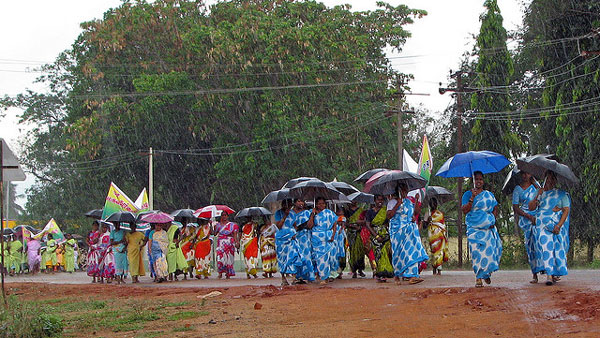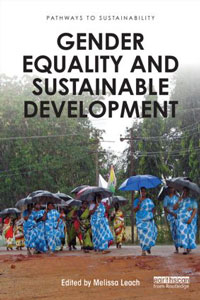This article is part of a series on the Sustainable Development Goals.
Feminists and their allies fought strongly for a stand-alone Sustainable Development Goal (SDG) on gender equality and empowerment of women and girls. Goal 5 now offers the potential to embed gender equality into transformative approaches to sustainable development.

For this promise to be fulfilled, however, it is vital that stand-alone does not mean siloed. Gender equality has implications for all the other SDGs, and as implementation proceeds, an integrated approach will be needed to maximise synergies and avoid unfortunate trade-offs.
Inextricable links
A new book, Gender Equality and Sustainable Development, shows the multiple interlinkages between gender equality and sustainable development. Unsustainable development and gender inequalities have shared root causes, in development models that support under-regulated market-led growth and the persistence of unequal power relations between women and men.
Environmental problems – whether related to climate change or water, forests or food, energy, infrastructure or urbanisation – can intensify gender inequalities, as women and girls are disproportionately affected by economic, social and environmental shocks and stresses.
Women’s knowledge, work and action are often central to creating and maintaining sustainable environments, economies and societies, whether in managing local landscapes, adapting to climate change, producing and accessing food, or securing sustainable water, sanitation and energy services.
If attempts to address other SDGs ignore gender, they risk missing their mark, or worse, undermining women’s rights and capabilities further. Investments in sustainable agriculture that overlook women’s rights to land and central roles as food producers can marginalise women, for instance.
An integrated approach across goals and sectors opens the way to recognise and support synergies in which gender equality and sustainability reinforce each other in alternative pathways.
Building synergistic pathways
Many successful examples of such pathways are emerging across the world, often starting locally but scaling up and out through networking and learning.
In relation to forests, for example, women’s full participation in local governance arrangements benefits livelihoods and conservation as well as women’s status.
Networks of grass-roots women leaders are working to scale up capacity to reduce vulnerabilities to climate change in their communities.
Initiatives to enhance women’s access to and control over appropriate everyday technologies in four priority sectors – water, safe sanitation, clean cook stoves, and electricity – are proving both transformative for sustainability, and for women’s health, dignity and work, and for poor women in particular.
Such examples show that for pathways to be truly sustainable and advance gender equality and the rights and capabilities of women and girls, those whose lives and wellbeing are at stake must be involved in leading the way, through community groups, women’s organisations and other forms of collective action and engagement – supported by appropriate forms of investment and public services.
Beyond siloes and stereotypes – relationships and politics
However, a simple “win-win” relationship between gender equality and sustainability cannot be assumed. Indeed, a policy focus on women can risk casting them as ‘sustainability saviours’ in ways that stereotype their roles in relation to the family, the community and the environment.
Such responses often add ‘environment’ to women’s already heavy unpaid care and work burdens, creating trade-offs with one of Goal 5’s key targets – to recognise and value unpaid care and domestic work. The importance of this target area for women’s empowerment – and ways to tackle it – are highlighted by recent analysis and experience.
Furthermore, gender is always and everywhere cross-cut by other, intersecting power relations and inequalities, whether around class or ethnicity, age or place, status or sexuality.
Supporting gender equality in real contexts means not siloing ‘women’ as if they were a homogeneous category, or individual victims, saviours or development beneficiaries; this may entrench stereotypes, while ultimately failing to empower. Instead, we need approaches that address and challenge the power relations and structures that create and sustain discrimination.
Here again, combinations of grassroots activism and enabling national and global policy frameworks offer key ways forward. In relation to LGBT rights, for instance, activists, lawyers and researchers have together developed a practical toolkit to guide campaigning for legal and policy change around sexuality and social justice , and this is now being picked up by others working in some of the most difficult and sensitive contexts.
Attention to gendered power relations, in all their rich, intersecting variety, must therefore remain centre stage if Goal 5’s promise is to be met. But beyond this, gender issues are vital for the whole SDG agenda – requiring integrated attention throughout the implementation processes to come.
A version of this article first appeared on the Huffington Post as part of a series on the SDGs. For more on this topic, see our series on the Sustainable Development Goals.
Book: Gender Equality and Sustainable Development
 Gender Equality and Sustainable Development
Gender Equality and Sustainable Development
Melissa Leach (ed.)
Routledge, 2015
Order the book at a 20% discount online: use code DC361
Gender Equality and Sustainable Development calls for policies, investments and initiatives in sustainable development that recognize women’s knowledge, agency and decision-making as fundamental.
The book includes an introduction co-authored by Prof Leach with Preetha Prabhakaran and STEPS water and sanitation convenor Lyla Mehta.